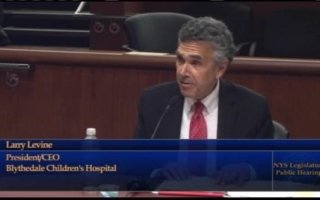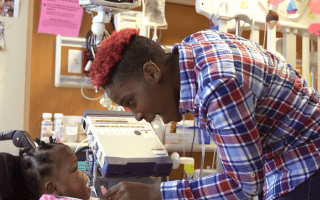Build Back Better for Kids
- Larry Levine

Congress is debating the proposed $3.5 trillion social infrastructure legislation against a backdrop of searing political divisions. The focus has been on total cost and choosing which initiatives to cut out or cut back. But there is one area that can unite us all – red and blue states, conservatives, moderates, and progressives: children’s health and well-being. Money spent on kids is not just an expenditure, it's an investment in strengthening our country that will pay future dividends for us all.
As a children’s hospital CEO, I watch kids of all racial and economic backgrounds, and families of all political affiliations, come through our doors. In the blink of an eye, their lives have been turned upside down, often by a devastating diagnosis. All our nation’s schisms vanish as they enter; politics becomes suddenly, and completely, irrelevant. Each child is simply a patient needing care, and our mission is to provide the very best care possible.
Due to vast research on social determinants of health, we also know that it is essential to kids’ physical health and cognitive development to meet a child’s basic needs: food, clothing, housing, consistent and prompt medical care, and early childhood education. An ounce of prevention is resoundingly worth a pound of cure.
After 45 years in the children’s hospital field, I consider it my responsibility to advocate for what I've learned is vital to the health and quality of life of children. I call upon Congress to adopt the following pro-working families agenda within Build Back Better:
- Cut child poverty in half by making the child tax credit permanent. In a ranking of 26 OECD nations, the US has the highest rate of child poverty. The child tax credit, using a strict means test, would provide $3,000 for qualifying children ages six to 17 and $3,600 for children under six.
- Expand funding for nutritious school breakfasts and lunches in low-income communities, as well as for SNAP, the nation’s food stamp program. One out of seven children–10.7 million kids–go hungry every day.
- Provide universal pre-K, using a sliding scale for eligibility. Investing in early childhood education produces cognitive gains for both low-income and middle-class children, with returns in long-term earnings of up to $8 for every dollar spent.
- Lower the high costs of child care for low and middle-income families, for whom it takes a large chunk out of budgets already stretched to cover food, housing, clothing, and health care. Too often, this forces a family member to leave work to care for a child, limiting household income and decreasing our tax base.
- Make Children’s Health Insurance Program (CHIP) funding permanent, like other insurance assistance plans. CHIP covers nine million children whose families make too much to be eligible for Medicaid but too little to afford private health insurance. Permanent coverage would remove CHIP from partisan budget battles and end anxieties about disruption to these children’s health care.
- Expand funding for pediatric home and community-based services for children with disabilities and special medical needs. Medical advances have led to the survival of millions of children, most of whom can be cared for at home, avoiding the pain of separation and the high cost of government-sponsored institutional care. Investments in the health home program, in particular, would help low and middle-class families with medically fragile children obtain essential interventions and resources, and navigate the complicated network of health, educational, and social services. They ultimately reduce government expenses by addressing issues as they occur, preventing greater costs down the road.
- Make Medicaid subsidies available to residents of the 12 states currently forgoing Medicaid expansion. Children make up 40% of Medicaid enrollees; thousands upon thousands of children in these states remain uninsured, lacking access to regular health care.
- Invest in pediatric behavioral health by expanding community-based services and increasing the number of pediatric mental health professionals.
I can already hear the criticism that “We don't have the money to pay for this”–except that we do. What has been lacking is the political will to readjust priorities. Let's recognize that our budget is not just a financial document; it's also our most fundamental statement of values as a society. And how to pay for improvements in children’s health and well-being? To begin with, redirect the billions annually spent in Afghanistan; recoup hundreds of billions of dollars in savings by allowing the federal government to negotiate the cost of pharmaceuticals; and re-examine the fairness of our tax policies.
Congress, as you negotiate Build Back Better, put children and families at the top of your agenda. Protecting them ensures a better present and future for our nation. And, because it benefits both red and blue state families, it's even good politics as well.
Larry Levine is the President & CEO of Blythedale Children’s Hospital in New York, a position he has held for the last 20 years. Mr. Levine's opinions are based upon his 45 years of work in the children’s hospital field, talking to parents about their families and children’s needs.



